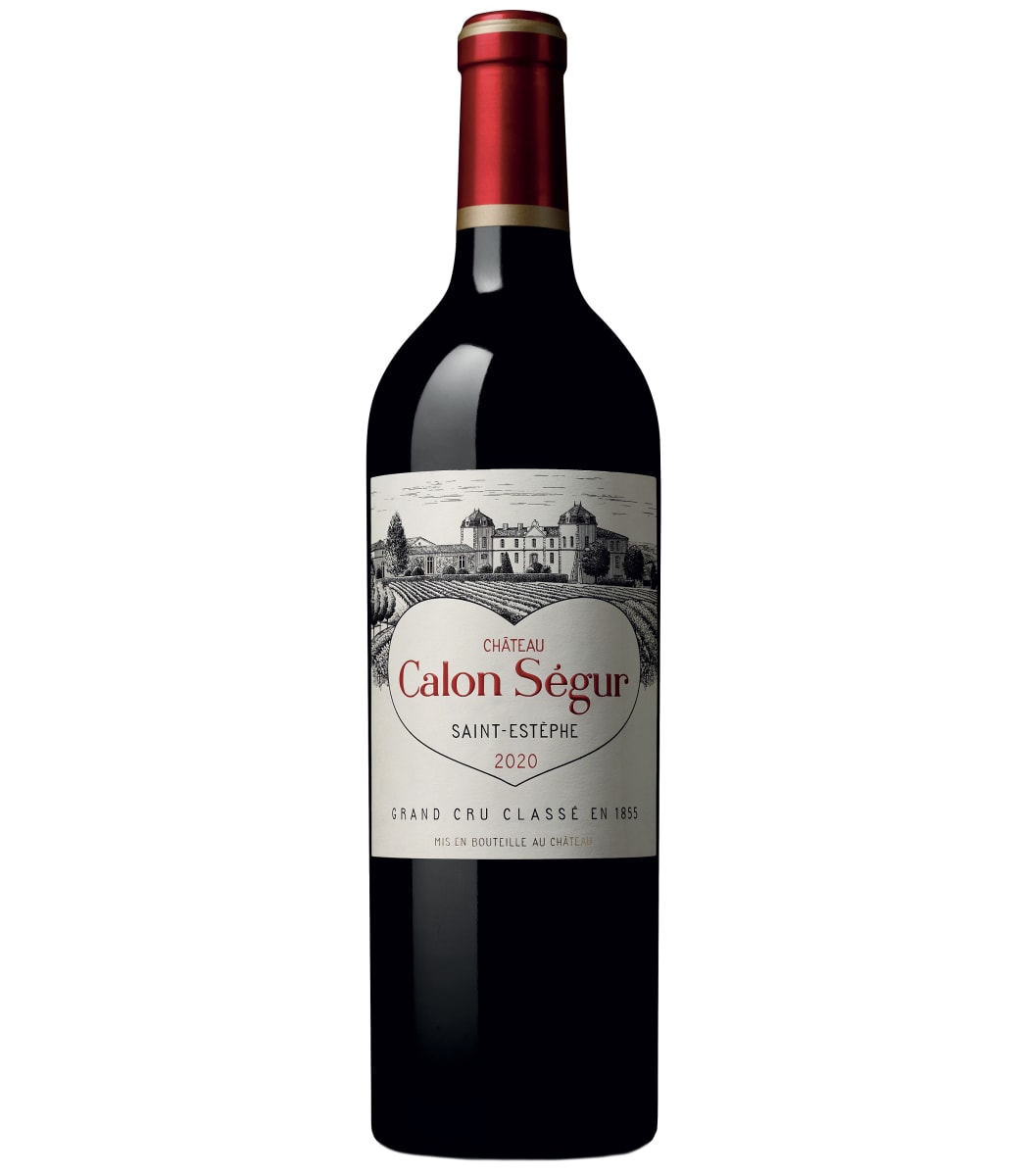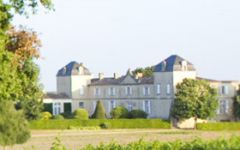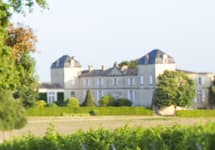Chateau Calon-Segur 2020
-
Jeb
Dunnuck - Decanter
-
Robert
Parker -
Wine
Enthusiast -
James
Suckling -
Wine
Spectator



Product Details
Your Rating
Somm Note
Winemaker Notes
The Grand Vin of Calon Ségur mirrors its terroir. It is rare, authentic and stirs the soul. In the most natural way, it reveals both great delicacy and outstanding intensity. All the magic of Calon is in this balance. The wine is aged in new oak barrels for 20 months, the tannins of the oak integrating harmoniously over time with the tannins of the grapes. The style is brought by a Cabernet Sauvignon which expresses its finesse without arrogance. Elegance is to be found everywhere, in the purity of the wine’s flavors, in the delicacy of its texture, while its depth and length are also superb. The wine’s extraordinary ability to age many years in bottle is another feature of the estate. The 1947, 1953 and 1982 vintages, by way of example, still display astonishing signs of youth.
Professional Ratings
-
Jeb Dunnuck
The 2020 Château Calon Ségur is pure gold and another masterpiece from this estate. Harvested all in September and pulled from their 48 hectares of vines, the blend is 78% Cabernet Sauvignon, 12% Merlot, 9% Cabernet Franc, and the rest Petit Verdot that spent 20 months all in new French oak, and it hit 13.2% natural alcohol. My notes started and ended with "wow," and this riveting Saint-Estèphe offers a heavenly bouquet of red and black currants, truffly earth, iron, espresso, and tobacco leaf. With incredible purity of fruit, full-bodied richness, and ultra-fine tannins, it's a deep, pure, layered 2020 that deserves at least 7-8 years of bottle age and will cruise for 40-50 years in cold cellars. Hats off to the team at Calon Ségur.
-
Decanter
Very deep perfumed nose; the 1% Petit Verdot is quite potent and intense with ripe fruit aromas. Super-smooth and silky on the palate however, just so juicy and lovely with ample balance. A lovely energy and freshness comes across as both sharp and well defined – succulent but remaining intense and linear in terms of structure. The weight comes from plump, ripe fruit – the blackcurrant, black cherry and plum offset by a cooling minerality and wet stone, pencil lead minerality. It has richness for sure, the concentration is there, but also sleight of hand, so well executed and long. Really very impressive.
-
Robert Parker's Wine Advocate
The 2020 Calon-Ségur is a brilliant wine from an estate in the ascendant. Wafting from the glass with aromas of cassis, red berries, fresh mint, pencil shavings, violets and rose petals, it's medium to full-bodied, deep and layered, with a vibrant core of fruit, powdery structuring tannins and a long, perfumed finish. Integrated and harmonious, this pure, concentrated and dynamic wine is one of the finest vintages that Vincent Millet and his team have produced to date.
-
Wine Enthusiast
This wine has a touch of spice to go with its powerful black currant flavors. It is concentrated, and the 78% Cabernet Sauvignon gives great structure and power. The wine has immense aging potential. Drink from 2028.
Cellar Selection -
James Suckling
Blueberries, blackberries, spearmint, currants and sweet spices on the nose. Mocha and walnuts, too. Lots of flavor here, with a medium to full body and muscular yet velvety tannins that melt seamlessly into the wine. Long, polished and delicious already. Keeps going. Better from 2025.
-
Wine Spectator
This is among the more backward wines of the vintage, showing a slightly burly mix of chestnut, warm paving stone, bay leaf and burnished leather notes amid a densely packed core of black currant and bitter plum reduction. Really riveted, with a warm cast iron spine and a mouthwatering savory edge driving the finish. Lovely character in this wine. Cabernet Sauvignon, Merlot, Cabernet Franc and Petit Verdot. Best from 2026 through 2040.
Other Vintages
2024-
Robert
Parker - Vinous
-
Jeb
Dunnuck -
James
Suckling - Decanter
- Vinous
-
Robert
Parker
-
Robert
Parker -
Jeb
Dunnuck -
James
Suckling -
Wine
Spectator - Decanter
-
Wine
Enthusiast - Vinous
-
Jeb
Dunnuck -
Robert
Parker - Decanter
-
James
Suckling -
Wine
Spectator
-
Wine
Enthusiast -
Jeb
Dunnuck - Decanter
-
James
Suckling -
Wine
Spectator -
Robert
Parker
-
Jeb
Dunnuck -
Robert
Parker -
James
Suckling -
Wine
Enthusiast -
Wine
Spectator - Decanter
-
Wine
Enthusiast -
Robert
Parker -
James
Suckling - Decanter
-
Jeb
Dunnuck -
Wine
Spectator
-
James
Suckling -
Jeb
Dunnuck -
Wine
Spectator -
Robert
Parker -
Wine
Enthusiast - Decanter
-
Wine
Enthusiast -
James
Suckling - Decanter
-
Jeb
Dunnuck -
Robert
Parker -
Wine
Spectator
-
James
Suckling - Decanter
-
Wine
Enthusiast -
Jeb
Dunnuck -
Wine
Spectator -
Robert
Parker
-
Wine
Enthusiast -
Wine
Spectator -
James
Suckling -
Robert
Parker
-
James
Suckling -
Wine
Spectator -
Robert
Parker
-
Wine
Enthusiast -
James
Suckling -
Robert
Parker
-
Wine
Spectator -
James
Suckling -
Robert
Parker
-
James
Suckling -
Robert
Parker - Decanter
-
Wine
Spectator -
Jeb
Dunnuck
-
Robert
Parker -
Wine
Spectator -
James
Suckling -
Wine &
Spirits
-
Robert
Parker -
Wine
Spectator -
James
Suckling
-
James
Suckling -
Wine
Spectator
-
Wine
Spectator -
Wine
Enthusiast -
James
Suckling -
Robert
Parker
-
Wine
Enthusiast
-
Jeb
Dunnuck -
Robert
Parker -
Wine
Spectator
-
Robert
Parker -
Wine
Spectator -
Wine
Enthusiast
-
Robert
Parker -
Wine
Spectator
-
Wine
Spectator -
Robert
Parker
-
Robert
Parker

One of the world’s most classic and popular styles of red wine, Bordeaux-inspired blends have spread from their homeland in France to nearly every corner of the New World. Typically based on either Cabernet Sauvignon or Merlot and supported by Cabernet Franc, Malbec and Petit Verdot, the best of these are densely hued, fragrant, full of fruit and boast a structure that begs for cellar time. Somm Secret—Blends from Bordeaux are generally earthier compared to those from the New World, which tend to be fruit-dominant.

Deeply colored, concentrated, and distinctive, St. Estephe is the go-to for great, age-worthy and reliable Bordeaux reds. Separated from Pauillac merely by a stream, St. Estephe is the farthest northwest of the highest classed villages of the Haut Medoc and is therefore subject to the most intense maritime influence of the Atlantic.
St. Estephe soils are rich in gravel like all of the best sites of the Haut Medoc but here the formation of gravel over clay creates a cooler atmosphere for its vines compared to those in the villages farther downstream. This results in delayed ripening and wines with higher acidity compared to the other villages.
While they can seem a bit austere when young, St. Estephe reds prove to live very long in the cellar. Traitionally dominated by Cabernet Sauvignon, many producers now add a significant proportion of Merlot to the blend, which will soften any sharp edges of the more tannic, Cabernet.
The St. Estephe village contains two second growths, Chateau Montrose and Cos d’Estournel.


